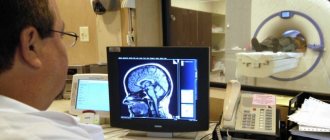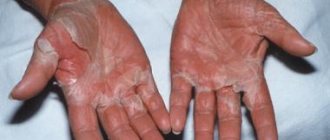Types of dermographism
Depending on the clinical picture, several types of disease are distinguished:
- White dermographism. In the corresponding zone of skin irritation, whitish stripes appear within 3-5 seconds after a small impact on it, which disappear in a few minutes.
- Edema dermographism. At the site of physical irritation, oblong edematous ridges 5–15 mm wide and 1–2 mm high appear. The swelling increases gradually, sometimes over several hours, and disappears very slowly.
- Red dermographism. Characteristic signs are the formation of red hyperthermic stripes in the area of direct skin irritation. They appear 15 minutes after mechanical impact. In the chronic course of the disease, traces remain for an hour or two. The acute stage is characterized by an increase in the time of manifestation of the disease to 1–3 days.
- Urticarial dermographism. It is the most common type of dermographism, accounting for 15% of all skin diseases. With urticarial dermographism, in addition to stripes and spots, an itchy rash appears on the irritated skin.
Folk recipes
You can relieve skin inflammation and itching using traditional medicine.
Herbs have a calming effect:
- celandine;
- series;
- white chamomile;
- mint.
They can be used separately or mixed in equal proportions.
The herbal decoction is prepared in the usual way:
- 1 tbsp. l. per glass of boiling water.
- Depending on the area of the skin lesion, you can take from 2 to 10 parts of dried raw materials, prepare a decoction and use it for dousing after taking a shower.
- With regular daily use, lasting results can appear in 1.5-2 weeks.
Causes of dermographism
All types of disease have different etiologies. The cause of white dermographism is vasospasm. This form of skin response can occur in any person, but most often develops in asthenic people, in whom the tone of the sympathetic nervous system predominates.
Red dermographism, the causes of which lie in the predominance of the tone of the parasympathetic part of the nervous system, is a response to irritation in the form of capillary dilation.
Edematous dermographism develops as a result of allergies. As a result of mechanical action, the integrity of the mast cell membranes is disrupted. They release histamine, heparin, and serotonin, which cause an allergic reaction. Under their influence, the walls of blood vessels become more permeable, which provokes tissue swelling.
Reflex dermographism is the action of a reflex arc that passes through certain segments of the spinal cord.
Symptoms
The main signs of red dermographism appear externally on the skin, but at the same time they are almost always accompanied by a deterioration in health. General symptoms of the disease include:
- the appearance of swollen red or pink stripes at the site of the streak effect on the skin;
- the appearance of itchy rashes in the form of small rashes or blisters on the affected area;
- development of physical and psychological exhaustion.
Red welts, swelling, itching, burning and rashes develop even with minor friction and last from several hours to several days. In most cases, these symptoms appear and disappear suddenly. The most unpleasant thing is that symptoms that appear at least once can continue to manifest themselves throughout life, without affecting its duration, but significantly reducing its quality.
In addition, when scratching itchy, inflamed areas, the integrity of the skin is disrupted, which is dangerous due to infection. A constant feeling of severe discomfort and deterioration in appearance can cause serious psychological problems. Therefore, the disease requires mandatory competent diagnosis and subsequent adequate treatment.
Signs of dermographism
With white dermographism, after running a stick with a blunt end over the skin, a white stripe immediately appears, disappearing after a few minutes. If the stick is applied with great pressure on the skin, a red stripe is visualized, which will disappear only after a few hours, which is a manifestation of red dermographism.
Severe mechanical irritation of the skin with a stick with a blunt end can provoke edematous dermographism. In this case, first a red stripe forms in the area of direct contact of the skin with the stick, which after 2–3 minutes turns white, swells and swells.
Urticarial dermographism is caused by increased permeability of the vascular walls. As a result, even minor irritation of the skin, such as from the elastic of socks or a trouser belt, leads to the formation of a red stripe surrounded by blisters and a rash.
If you run a sharp needle across the skin, within half a minute a wide red stripe will appear on the surface of the skin. After a few seconds she turns pale and disappears. This is a manifestation of reflex dermographism.
General characteristics of the disease
The term “dermography” comes from the words derma - skin and grapho - write. Translated from Greek, it means “skin writing” or “skin writing.” In a person suffering from dermographism, the skin is indeed constantly “painted” with various symbols, similar to mysterious inscriptions. They are formed even from minor exposure to seams on clothing, folds of bed linen, or touching with a blunt object. These can be stripes of different sizes and shapes, characterized by slight swelling and redness or paleness of the skin.
Important! Similar manifestations occur in every person. But if dermographism is normal, then with increased pressure on the skin, the affected area first turns pale and then acquires a natural color or a slightly reddish tint, which quickly disappears.
With dermographic urticaria, the pressure mark is distinguished not only by a more pronounced change in color, but also by swelling of the skin with itchy rashes on it. Such symptoms persist for several hours or days.
Diagnostics
Dermographism is not a disease, but only one of the signs of pathology, which can be considered as a symptom in its complete absence or in its strong manifestation.
With pronounced dermographism, one can assume the presence of meningitis, thyrotoxicosis, or autonomic neurosis. The absence of a skin reaction to irritation or its weak manifestation is observed with intoxication of the nervous system or general exhaustion of the body. Therefore, when skin patterns are detected, the patient is referred for examination to differentiate these diseases.
First, a skin reaction test is performed to exposure to a solid object, as well as to cold, water, and heat. If, after an initial examination of the epidermis and the test, a suspicion of dermographism arises, the following studies are indicated:
- immunodiagnostics;
- encephalogram of the brain to diagnose the functioning of the central nervous system.
If necessary, stool tests and blood tests for hormones and parasites may be required.
Dermographism is not a disease, but only one of the signs of pathology, which can be considered as a symptom in its complete absence or in its strong manifestation.
Since dermographism may indicate a number of diseases, consultation with specialized specialists - an immunologist, endocrinologist, neurologist - may be required.
Diagnostic value of the disease
Direct determination of dermographism as a diagnosis is not difficult - this is easily done by pronounced characteristic manifestations on the skin during a visual examination and testing the skin for mechanical impact. However, this dermatological pathology is rarely an independent disease - most often it is one of the symptoms of the underlying disease. Therefore, it is impossible to say exactly which doctor treats dermographism. This could be an allergist, gastroenterologist, immunologist, neurologist, dermatologist or another specialist. To determine the cause and prescribe the correct treatment, it is extremely important to undergo a thorough diagnosis.
Important! Dermographism in children requires special attention, since in childhood the risk of disease progression, complications and side effects from treatment increases significantly.
Diseases that cause dermographism pose a particular danger to a child. They can lead to the development of the following negative consequences:
- damage to various internal organs;
- decreased motor ability;
- changes in hormone levels;
- metabolic disorders at the cellular level;
- change in blood formula;
- disability, asphyxia, death.
Therefore, when the first signs of dermographism appear in children, you should immediately contact your pediatrician. Self-medication is strictly forbidden. Only qualified medical care can provide quality treatment and prevent the development of complications.
Before treating dermographism, a child or adult patient first undergoes a differential examination to identify or exclude the most likely diseases:
- exhaustion, disorder or intoxication damage to the nervous system;
- psoriasis, other dermatoses;
- vegetoneurosis, vegetative-vascular dystonia;
- hyperthyroidism;
- meningitis, disorders of the central nervous system;
- disturbances of sympathetic innervation;
- parasitic infestations;
- increased swelling;
- exposure to allergens;
- hormonal imbalances;
- metabolic disorders;
- autoimmune, cardiovascular pathologies;
- infectious processes in the body;
- hereditary predisposition.
To identify the cause of dermographism, the following are prescribed:
- laboratory tests of blood and feces for the presence of parasites;
- blood test for hormone levels;
- encephalogram of the brain to establish the functionality of the central nervous system;
- immunogram to check the state of the immune system;
- allergy tests;
- Ultrasound of internal organs,
- tomography, x-ray;
- biopsy.
Based on the results of diagnostic studies, the root cause of skin hypersensitivity is determined and a course of treatment is prescribed.
Treatment
Treatment of dermographism is carried out only in case of severe manifestations, accompanied by itching. Drug therapy is aimed at eliminating local symptoms and treating the underlying disease.
Prescribed:
- antiallergic drugs (to reduce skin irritation);
- tranquilizers and antidepressants (Diazepam, Phenazepam, Doxepin, Paxil);
- drugs with a sedative effect, including vitamin B;
- ascorbic acid, flavonoids (vitamin P, Rutin) (to reduce the permeability of vascular walls);
- vasoconstrictors (for red and vasodilators for white dermographism);
- antipruritic ointments;
- Ketotifen (in the presence of urticarial dermographism);
- choleretic drugs;
- lactobacilli and bifidobacteria;
- external antiseptics based on camphor and salicylic acid.
Sometimes exposure to ultraviolet light has a positive effect.
With the help of timely identification of the causes that provoke dermographism and their elimination, it is possible to achieve stable remission, and in some cases, completely get rid of such manifestations.
Types and causes of cutaneous dermographism in children and adults, treatment and prevention of pathology
For some reason, it has turned out that many people have a completely frivolous approach to skin diseases. Sometimes they are not given due attention. Meanwhile, such a disease as red dermographism is a rather serious pathology that requires certain therapeutic measures, and can ultimately lead to the most unpleasant consequences.
What is dermographism?
Pathology is a response that subcutaneous vessels exhibit in response to tactile irritation of the skin. The tactile effect is mechanical in nature, when strokes are applied to the surface of the skin with a stick.
It is characteristic that skin dermographism can be normal, which is observed in 98% of the population. Its diagnosis is of great importance in identifying various disorders manifested by the nervous system, in particular its autonomic department.
If irritated at the time of examination, the skin initially turns white. After a certain time (9-20 seconds) the color turns from white to red. This appearance is due to irritation of small subcutaneous capillaries. The strip can have a different color and width, and it depends on the tone of the autonomic nervous system.
This is a peculiar reaction of capillaries in response to many factors. For example, this may cause an increase in body or external temperature.
Features of the species
This pathology can exist in four main forms. This is due to the situation in which one or another symptom occurs.
Dermographism white
When, after 9-27 seconds, a white stripe appears on the skin of the person being examined, it should be said that manifestations of white dermographism are occurring. This state can persist for 5-10 minutes. After this time, these phenomena disappear without a trace. Increased manifestations may occur.
This is due to the increased response exhibited by skin vasoconstrictors. During diagnostic procedures, it is better to carry out the test on the hip. In this place, such a phenomenon as the “white spot” will manifest itself well. This manifestation occurs if you press on the thigh with a finger and hold for 2-3 seconds.
If after three seconds the spot does not disappear, then the symptom is considered positive.
Red
One of the normal variants is red dermographism. Of course, the condition is considered normal if there is no itching, parasthesia, and the stripe completely disappears. You can see the appearance of signs of pathology right at home.
It is enough to apply some effort to the tool with which the skin strokes are applied. This will cause a situation in which red stripes will begin to appear. After 8-10 seconds, the skin, or rather the stripes on it, become hyperemic.
Manifestations of red dermographism are associated with age-related characteristics.
There are also pathological variants, which can also be types of dermographism.
Edema, reflex
They are represented by the following states:
- Edema dermographism. It looks like hives. Swollen red stripes appear on the skin. Over time, a rash appears on the periphery of the stripes. Hives can occur over a period of 20 minutes to one hour. The adult population suffers from this pathology in 5-7%.
- Urticarial dermographism is quite widespread. The phenomenon is quite common and occurs in the population in 6% of cases. Against the background of complete health, the skin suddenly begins to itch. A rash appears that has an oblong shape, which takes on the appearance of a blister. A distinctive feature that distinguishes it from other species is the absence of itching.
- Reflex dermographism. It can be observed by running a needle or some other sharp object across the skin. After 40 seconds, a fairly wide red stripe appears on the skin. After a couple of minutes it turns pale and disappears completely. This type is a physiological reflex and not a local reaction. This phenomenon is typical for cases where the peripheral nervous system is affected. This can also be observed in cases where vasodilating centers located in the spinal cord die.
Dermographic urticaria: causes, symptoms, diagnosis, consequences and treatment
Phenomena associated with white dermographism are not considered pathological. They are observed in almost the entire population. They are most pronounced in asthenics. The appearance of white stripes is the result of spasm of blood vessels located under the skin. The occurrence of a situation associated with red dermographism is due to the influence of the parasympathetic part of the nervous system.
The cause of this phenomenon can be a variety of factors. However, it cannot be said that they are fully and well studied. These include the following points:
- Prolonged exposure to cold or thermal factors.
- Tight, constrictive clothing against which the skin rubs.
- Traumatic factor in the form of blows.
- A certain role is played by factors associated with genetic predisposition.
- The occurrence and development of allergic reactions.
- The reason may also be a disorder of the digestive tract. These include phenomena associated with dysbacteriosis, inflammatory changes in the stomach, the vital activity of Helicobacter Pylori, damage to the body by helminths, and other issues.
- Pathology associated with the thyroid gland.
Provoking agents can be bad habits associated with smoking and tobacco use, harmful working conditions, wearing clothes that can cause maceration phenomena, and other factors.
Features of skin disease in a child
The reasons why red dermographism occurs in children and adolescents can be a variety of factors, but they have not yet been fully studied. Rashes and redness appear that remain on the skin for a period of several hours to several days. After this, they disappear without a trace, without causing any complications.
Symptoms of various forms of dermographism in adults and children
The symptoms of diseases depend and are determined by the type of dermographism. The patient’s condition can be described after an external examination.
For diagnostic purposes, a special test is used to determine the vasomotor reaction. To do this, use the opposite end of a pen or pencil.
The appearance of pale pink stripes with various shades of color is accepted as the norm.
As a rule, the patient comes to the doctor’s appointment already with the presence of rashes. The skin is irritated with high sensitivity. Naturally, this causes a lot of inconvenience to the patient. Sometimes insomnia occurs. Blisters similar to a mosquito bite may appear. There is often itching and burning. The appearance and disappearance of symptoms is not associated with either the circadian rhythm or food intake.
Diagnosis of skin pathology
It is not difficult to recognize this condition, since the manifestations on the skin are clearly defined. It is enough to carry out an inspection. A dermographometer device is used to perform the test. The results are assessed 10 minutes after the test is administered. Concomitant diseases are also diagnosed.
How to determine that dermographism in a child and an adult is normal?
Dermographism in children is normal when the child is 3-10 years old, holding the red color of the stripe for 3-4 seconds. In older children, aged 10-15 years, this phenomenon lasts a quarter of a minute.
The skin of an adult can maintain the presence of a red stripe for up to 35 minutes. If crimson stripes appear, the edges of which are framed by a white corolla, then this is also a normal variant.
What you need to know about chronic urticaria
Many people suffering from this pathology often ask the question of how to treat red dermographism? Treatment of a condition associated with dermatographic urticaria should be paralleled by measures aimed at eliminating the causes. It is necessary to treat not only dermographism itself, but also the diseases accompanying it.
Therapy should be aimed at relieving symptoms and eliminating factors contributing to the development of the disease. It is impossible to completely cure the disease, but therapeutic measures often result in stable remission.
The use of conservative or alternative methods allows you to maintain the patient in good condition.
Conservative therapy involves the use of the following means.
Decongestant ointments
The use of Lekomax and Troxevasin ointments will help reduce swelling. Their action is associated with the restoration of mast cells. The result will be a decrease in the permeability of the vascular bed, and as a result, the elimination of edema.
Antipruritic drugs
For this purpose, you can use regular heparin ointment. A lasting effect can be achieved by using Sinaflan and Gerpevir. You can try any other ointments that are commonly used after insect bites. How often to use such ointments depends on the nature and area of the lesion. Some people benefit from procedures using ultraviolet irradiation.
Antihistamines
Of the drugs in this group, we can recommend Claridol, Clarisens. The proven remedy Suprastin has a good effect.
Choleretic drugs
Drugs from this group are also indicated for red dermographism. The use of Cholenzin, Hologon, and Decolin is recommended.
Lacto and bifidabacteria
The use of such drugs is carried out with the aim of restoring the intestines. Use products such as "Acilact".
How to treat pathology with folk remedies?
Traditional medicine in its arsenal contains a lot of recipes to combat red dermographism. You can use nettle in the form of a decoction. It is used as an external agent.
You can try using raspberry rhizomes. The composition is used for internal use. The affected areas can be lubricated with olive oil.
You can apply a mass of raw potatoes, wrapped in gauze, to the affected area.
Diet, proper nutrition for persistent dermographism
Many problems are associated with nutrition, including this pathology. It is better to use mainly plant foods in your diet. Products of an aggressive nature are excluded from the diet altogether, since they are pronounced provocateurs.
It’s not even worth mentioning about giving up alcohol and nicotine. The diet should contain vegetables and fruits, juices, and fruit drinks in sufficient quantities. Naturally, all of them should have a low allergic ability.
Lactic acid products should be on the table every day.
Preventive methods for adults and children
It is not always possible to prevent red dermographism. Nevertheless, preventive measures must be observed. No matter how trivial it may sound, a healthy lifestyle is the basis of prevention.
A rational regime of work and rest, combined with a nutritious balanced diet, in many cases allows one to avoid the disease. If possible, you need to protect yourself from stressful situations.
You need to stop making friends with bad habits once and for all.
When worn, clothing should not fit tightly to the body or have tight, rough seams. If a woman uses cosmetics, then she should have a low allergic nature. If you are going to be exposed to the sun for a long time, you should apply a protective cream to your skin.
Autoimmune urticaria: causes, complications, symptoms, diagnosis, treatment, prevention
The consequences of this pathology can be very different. With severe itching, scratches appear on the body, which will serve as an entry point for infection with the possibility of developing pustular skin diseases.
In conclusion, it should be said that this pathology is a rather serious disease that requires certain therapeutic correction.
Unfortunately, the disease cannot be completely cured, but it is quite possible to improve the patient’s quality of life. To do this, you need to consult a doctor as soon as possible.
It is necessary to identify and, if possible, eliminate the cause of this disease.
Source: https://allergolog.guru/zabolevaniya/krasnyj-dermografizm.html
Prevention measures
Primary preventive measures to prevent dermographism have not been developed, since the causes of its occurrence may be different. Secondary measures include activities aimed at preventing relapses.
Doctors recommend wearing loose clothing that does not allow friction or compression of the skin. It is useful to remove all chemicals and personal care products with fragrances from your daily routine, replacing them with hypoallergenic products.
With the help of timely identification of the causes that provoke dermographism and their elimination, it is possible to achieve stable remission, and in some cases, completely get rid of such manifestations. After treatment, most patients note an improvement in their general condition and a decrease in skin sensitivity.
Video from YouTube on the topic of the article:
Etiology
Red dermographism is nothing more than a reaction of the skin to thermal, mechanical and other external influences, against the background of which red marks appear on the skin that persist for quite a long period of time.
The reasons for the development of pathology remain not fully understood, however, among the predisposing factors are:
- prolonged exposure to low or high temperatures;
- friction of the skin against tight clothing;
- shocks and other impacts;
- exposure to stress and nervous strain;
- genetic predisposition;
- the course of allergic processes.
In addition, it is generally accepted that the development of such a disease is influenced by the state of the gastrointestinal tract, which is why the sources of the disease can be considered:
- chronic constipation;
- dysbacteriosis;
- gastritis of any nature;
- pathological influence of helminths, lamblia and other protozoa;
- disruption of the functioning of the thyroid gland, which often happens when it is partially removed;
- Gluten intolerance.











